Diffusion Chess
Introduction:
This game was developed for the 32 move chess variant contest at the Chess Variant Pages. When I decided to create a game for that contest, I wanted a mechanism for constraining the number of moves that would be unique, and I think I may have found it.
Setup:
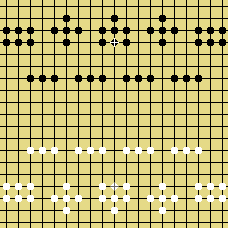 Each player begins with 41 pieces of one color placed on a 19 x 19 (go) board as shown. One of the pieces for each player (marked by diamonds below) is that player's king. (I use small black and clear Icehouse pieces for the kings, and go stones for the rest, but in these rules I use "stone" to mean any piece.)
Each player begins with 41 pieces of one color placed on a 19 x 19 (go) board as shown. One of the pieces for each player (marked by diamonds below) is that player's king. (I use small black and clear Icehouse pieces for the kings, and go stones for the rest, but in these rules I use "stone" to mean any piece.)
A Group is a set of stones that are vertically and horizontally connected. The size of the group a stone is in determines how it can move, and whether it can capture or be captured. In these rules, it is the size of the group a stone is in at the beginning of the turn that is relevant, even if during a turn the nature of the groups change.
Play:
Players alternate turns; white starts. A turn consists of five (normal or echo) moves in sequence, except for white's first turn, which consists of only 4.A normal move consists of moving a stone of one's color that one has not already moved this turn in a sequence of horizontal or vertical single steps. The steps need not be all in the same direction. The maximum number of steps a stone can move is equal to the size that the group it was in had at the beginning of the turn minus one. (It may move fewer than the maximum number of steps.) Therefore a single stone with no other stones in its group is stranded; it cannot move at all. If you move into a cell with an opponent's stone, that stone is captured. A captured stone is not removed from the board, but is swapped into the position the capturer moved from in its last step. After a capture is made, the move ends, and the capturing piece may not move again that turn. It is not legal to capture a stone in a group that is smaller than the group the capturing stone came from. (Remember, it is the size of the groups these stones were in at the beginning of the turn that matters.) It is also not legal to capture one's own stones.
If the previous move in a turn was a normal move, did not include a capture, and was not made with a king, an echo move may follow it. In an echo move, the piece that moved in the last move repeats the sequence of steps it made in that move. It will stop before the end of that sequence if it makes a capture, or if the next step in the sequence would be onto a stone that it cannot capture, or off the edge of the board.
Ending the game:
The game ends when one of two things occurs:- At the end of a move, if either player's king is stranded, (alone in its group,) that player loses. If both players' kings become stranded simultaneously, the game is a tie.
- At the end of a turn, if the number of groups on the board belonging to either player has not increased by at least one, the player whose turn it was loses. As a consequence of this rule, the maximum number of turns for each player is the number of their stones minus the initial number of their groups, or 32.
Capture, Group Count, and Reconsolidation:
It is also a consequence of the requirement of increasing the number of groups that capture is generally useful, despite the captured piece remaining on the board; if you can seperate your opponent's pieces into many groups, you have an advantage later in the ability to break apart your groups to create new ones. Usually in order to make a capture you will need to break one of your pieces out of its group. You can still come out ahead in group count by using your remaining moves to consolidate some of your other groups together elsewhere.It is possible for positions to occur where a capture does not increase the quantity of the opponent's groups. For example, in the diagram below (a and b,) white can capture the stone in the top center position, but that stone then joins another black group. (Notice that the other white stone cannot then capture the black stone on the right, because that stone started the turn in a group of size 1, and the white stone was initially in a group of size 2.) C, d, and e show how black can capture and reconsolidate from the same position.
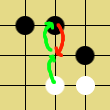 |
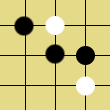 |
 |
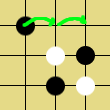 |
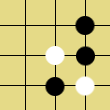 |
a | b | c | d | e |
Strategy and Thoughts:
Two strategies are apparent. A "Regicide" strategy would involve quickly sending small groups of pieces into the vicinity of the opposing king, hoping to seperate it from its guards, possibly sacrificing the potential for future moves in the process. A "Defense and Attrition" strategy would consist of guarding one's king while trying to keep a group count lower than the opponent's in the hope that the opponent will run out of moves first. Hopefully the game is balanced such that both of these strategies are viable and mixable, and neither dominates the other.There is also a tension in the size of groups one should keep. Larger groups offer mobility but little capturing power, and are themselves vulnerable to capture; they tend to be most useful deep in one's own territory. Smaller groups are potent at capturing, but relatively immobile, and are best near, (or behind,) enemy lines.
I've noticed in playtesting that keeping track of the number of groups and the size of groups stones came from is a little annoying, (although by no means impossible.) It would definitely be nice to let a computer keep track of all that.
Written by Alexandre Muñiz. Web page posted by David Howe.
WWW page created: 1 Aug 2000. Last modified on: 1 Aug 2000.